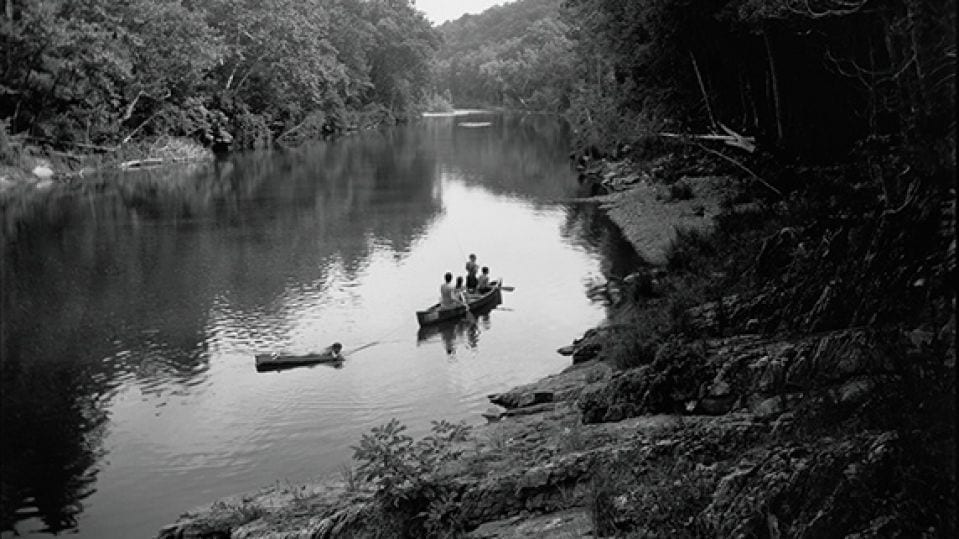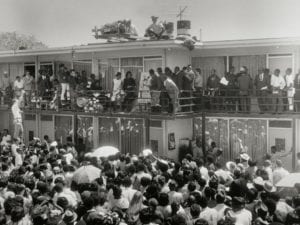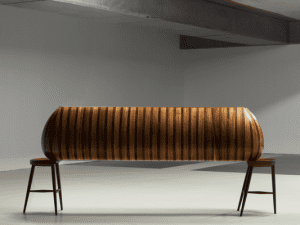It’s December and in Virginia, at Sally Mann’s countryside home, she has invited Bill T. Jones for a photo session. Death – its menacing approach or dark legacy – looms large in Mann’s work, and it’s no surprise to find the dancer-choreographer’s high cheekbones made skull-like behind her lens. “Almost a death mask,” she concludes in a video of the encounter shown in a major survey at the National Gallery of Art in Washington. Sitter and photographer, both 66, are keenly aware they have entered their final chapter.
Growing up in the American South, Mann has long had a fascination with slavery and the racism that replaced it. Jones in part inspired her monumental portraits of black men as she sought to reach across the “seemingly untraversable chasm of race.” The resulting images are as haunting as Mann is haunted by this tense history.
To delve into these very contemporary issues, Mann resorts to 19ᵗʰ century techniques and makes her own prints, at a time when most photographers have replaced the dark room with an inkjet printer. She pours syrupy collodion on a glass plate from her large format camera, then dips it in silver nitrate. It’s bulky, messy work, but Mann embraces the imperfections of her materials, which she likens to calling upon the “angel of uncertainty,” the nemesis of the Proustian “angel of certainty.”
She documented the southern landscape out of “shame and some inchoate sense of accountability,” focusing on markers of its violent past, including the site of the 1955 murder of 14-year-old African American Emmett Till, accused of seducing a white woman. Dust that formed on the plate created bullet-like dots and streaks in works like 2003’s Battlefields, Cold Harbor (Battle), a reminder of the death and destruction that once was and a cry against nature’s indifference to the crime.
The exhibition opens, aptly, with the beginning. It was the Immediate Family portraits of her husband and three young children caught in intimate, unguarded moments in various states of undress at their remote summer cabin that catapulted Mann to fame in 1992. But a quarter-century later, the intense controversy generated in the midst of America’s culture wars by these images of youth latent with sensuality, violence and even death seems a distant past. Yes, the blood streaming from Emmett’s Bloody Nose (1991) or Virginia’s seemingly lifeless body in Last Light (1990) are still startling. But, contextualised with the rest of her oeuvre, they appear as brutally honest depictions of fleeting hedonistic moments made with great maternal care, curiosity and awareness of lurking danger.
On a hillside near Mann’s home, Jones barely moves his body to poignantly communicate tragedy, hope and beauty in an invocation of sorts. Exhaling with a sweeping gesture, he proclaims: “Ward off all of my anger at the South. Ward off my closed heart, pregnant with potential in this moment.” Jones then turns away from the camera, outstretched hands facing upwards.
Olivia Hampton
Sally Mann: A Thousand Crossings, National Gallery of Art, Washington, runs until 28 May. For more information, click here.
On tour: Peabody Essex Museum, 161 Essex St, Salem, Massachusetts, 30 June – 23 September; The J. Paul Getty Museum, 1200 Getty Center Dr, Los Angeles, 20 November 2018 – 10 February 2019; Museum of Fine Arts, Houston, 1001 Bissonnet St, 3 March – 27 May 2019; Jeu de Paume, 1 Place de la Concorde, Paris, 17 June – 22 September 2019; High Museum of Art, 1280 Peachtree St NW, Atlanta, 19 October 2019 – 12 January 2020
Credits:
1. Sally Mann, On the Maury, 1992, gelatin silver print, Private collection. Image © Sally Mann.





